|
| |
Family
Tachinidae, Subfamily Dexiinae
- This page contains pictures and information about Tachinid
Flies in Rutiliini, subfamily Dexiinae (or Proseninae in some
reference) that we found in the Brisbane area, Queensland, Australia.
-
 -
- The Rutiliini include the largest and most handsome files. They are
usually brilliant metallic colours. Usually they have long legs with
face elongated under the eyes.
-
- Some of them look similar to those flies in Ameniinae, which is another group of large metallic flies in family
Calliphoridae.
-
- As other group in subfamily Dexiinae, flies in Rutiliini are parasitic in larval Coleoptera
(beetle) especially Scarabaeidae.
-
- Adults
are usually found resting on the sunny side of tree trunk. Adults feed on flowers, notably Eucalyptus.
Females rest on ground when larvipositing.
-
-
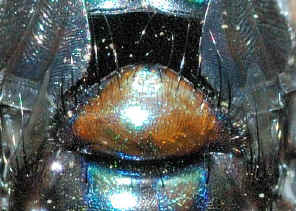


- Scutellum
Wing base dark
area
Resting on tree trunk
-
- Flies in tribe Rutiliini can be recognised the following characteristic;
- - typical dexiin face with facial carina and board gena,
- - eyes bare, hairless,
- - small antenna with bare arista,
- - scutellum with four or more pair of marginal setae,
- - robust body,
- - epistome produce in front of vibrissal insertions,
- - reduced vibrissae,
- - strong postalar setae,
- - cell R5 open, bend of vein M without appendix but close to wing margin,
- - dark area on wing base,
- - excavation of abdomen T1+2 reach to hind margin,
- - abdomen T5 often with median depression,
-
Genus Formosia (Euamphibolia)
- Black & White
Giant Fly



- Formosia (Euamphibolia) speciosa, body length 20mm
- Black and White Rutilia Fly is a very large size attractive fly with metallic
black and white
colours. They fly with a medium loud buzzing sound. We found the insect once
on Nov 2012 in
Karawatha Forest on Rocky Track. Please check this page
for more information.
-
Genus Rutilia
Subgenera Neorutilia - Blue Rutilia Flies
- There is only one species in this subgenera.
-
- Blue Rutilia Fly


- Rutilia (Neorutilia) simplex, body length
15mm
- This fly can be identified by its non-pollinose parafrontals brilliant
metallic green to blue-violet in colours, and its has three setae on
postalar callus. Check this page for more
information.
- There are three species in this subgenera Ameniamima. Flies in this subgenera
show strong convergent resemblance to Calliphorid
flies of genus Amenia.
They can be separated by the Amenia
flies have plumose antenna and a pair of silvery white pollinose spots on
postalar position.
-
- Species in subgenera Ameniamima can be identified by the followings;
- - bright orange yellow head,
- - four or five setae on postalar callus,
- - metallic green, blue to black,
- - with bold white pollen spots on thorax and
abdomen,
-
- Golden Head Rutilia Fly I


- Rutilia (Ameniamima) argentifera, body length 15mm, female, male
- This large Golden Head Rutilia Fly is metallic dark blue-green in colour with bright
orange-yellow colour head. On the thorax and abdomen there are the shiny white spots
patterns. Different individuals may have slightly different patterns. Please
click here for more information.
-
-
-
Golden Head Rutilia Fly II
-
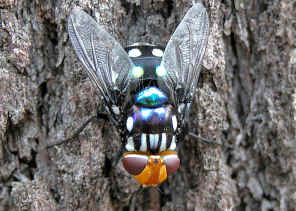
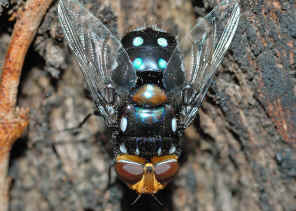
-
Rutilia (Ameniamima) cingulata, body length 15mm, female, male
- This large Golden Head Rutilia Fly is dark purplish
black in colour with non-metallic dark brown scutellum. Please check this page
for more pictures and information.
-
-
-
Rutilia (Ameniamima) quadripunctata,
body length 20mm, female, male
- This fly is seasonally common on the gumtree trunk in Karawatha Forest.
This is the largest Snail Parasitic Blowfly species. They
are mostly seen from mid Dec to mid Feb in eucalypt forests in Brisbane.
Please check this page for more
information.
-
Subgenera Chrysorutilia - Green Rutilia Flies
- This is a large group and there are at least six species can be found in
Queensland. The subgenera Chrysorutilia can be identified by the followings;
- - scutellum convex,
- - head with bright yellow ground colour,
- - four or five setae on postalar callus,
- - body colour in metallic golden green to blue green,
-
- Green Rutilia Fly I


- Rutilia (Chrysorutilia) formosa, body length
15mm
- In
early summer, we saw many of them resting on Iron-bark gum tree trunk in
Karawatha Forest Bushtail track. They look similar to the above species but
smaller in size, with bright green metallic colour. Please visit this page
for more information and pictures.
-
-
- Green Rutilia Fly II
-
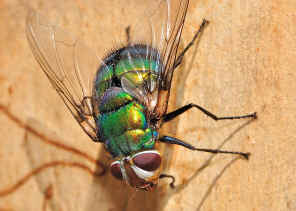

- Rutilia (Chrysorutilia) rubriceps, body length
15mm
- The fly's hairy
body was bright metallic golden-green in colour, a bit darker than the R.
(C.) formosa otherwise looked very similar. On the thorax there is the
white pollinosity but may not be very obvious on some individuals. Please
check this page for more pictures and
information.
-
-
- Green Rutilia Fly III


- Rutilia (Chrysorutilia) imperialis, body length 20mm
- This large Green Rutilia Fly is dark metallic green in colour. Its head
look darker that the other Rutilia Flies for there are the dark hairs on its
interfrontal area (middle of its face). Click on here for more information.
-
Subgenera Donovanius - Grey Rutilia Flies
- This is the largest subgenera group in Rutiliini and there are at least six
species can be found in Queensland. The subgenera Donovanius can be identified by the followings;
- - last abdominal T5 with a median depression,
- - four or five setae on postalar callus,
- - very large body size
-
- Grey Rutilia Fly I

 - Rutilia (Donovanius) viridinigra or inusta,
Male, body length 20mm
- Pictures taken in Karawatha Forest. This fly larvae parasites on Scarab
Beetle larvae. This is the largest Tachinid fly that we saw. They are usually found in forest or
semi-forest, resting with heading downwards on tree trunk about a meter from
ground. More information and pictures can be found in this page.
-
-
- Grey Rutilia Fly II
  - Rutilia (Donovanius) regalis, body length 20mm
- This is one of the largest Tachinid flies that we saw. Its hairy
body is metallic grey blue in colour, with dark patches near the base of the
wings. More information and pictures can be found in this page.
-
-
- Grey Rutilia Fly III
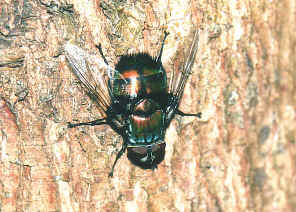 
- Rutilia (Donovanius) lepida, body length 15mm
- This is a medium size Grey Rutilia Fly with metallic dark brownish-green
body colours. More information and pictures can be found in this page.
-
-
- Grey Rutilia Fly IV
  - Rutilia (Donovanius) agaimiodes, body length 20mm, female, male
- From those pictures that we were taken, we noticed that
this fly likes to rest on large Paper Bark tree trunk. This is a very large Grey Rutilia Fly.
More information and pictures can be found in this
page.
-
Subgenera Rutilia - Brown Rutilia Flies
- Brown Rutilia Fly
-


- Rutilia (Rutilia) sp., body length 10mm
- This is a medium size Brown Rutilia Fly with dull brownish-grey
body colours. More information and pictures can be found in this page.
- Reference:
- 1. Insects
of Australia, CSIRO, Division of Entomology, Melbourne University
Press, 2nd Edition 1991, p 784.
- 2. Insects of Australia and New Zealand - R. J. Tillyard, Angus
& Robertson, Ltd, Sydney, 1926, p376.
- 3. Family TACHINIDAE - Australian Biological Resources Study, Australian Faunal Directory.
- 4. The systematics of the Australasian Dexiini (Diptera : Tachinidae : Dexiinae) with revisions of endemic genera - DA Barraclough, Invertebrate Taxonomy 1992, 6(5) 1127 - 1371.
- 5. A revisionary classification of the Rutiliini (Diptera: Tachinidae), : with keys to the described species - R. W. Crosskey, British Museum (Natural History),
Bulletin, Entomology, Supplement 19, 1973.
- 6. A conspectus of the Tachinidae (Diptera) of Australia, including keys to the supraspecific taxa and taxonomic and host catalogues - R. W. Crosskey, British Museum (Natural History),
Bulletin, Entomology, Supplement 21, 1973.
-
- Back to Top
-
- [ Up ] [ Rutiliini ] [ Dexiini ]
| |
|






























